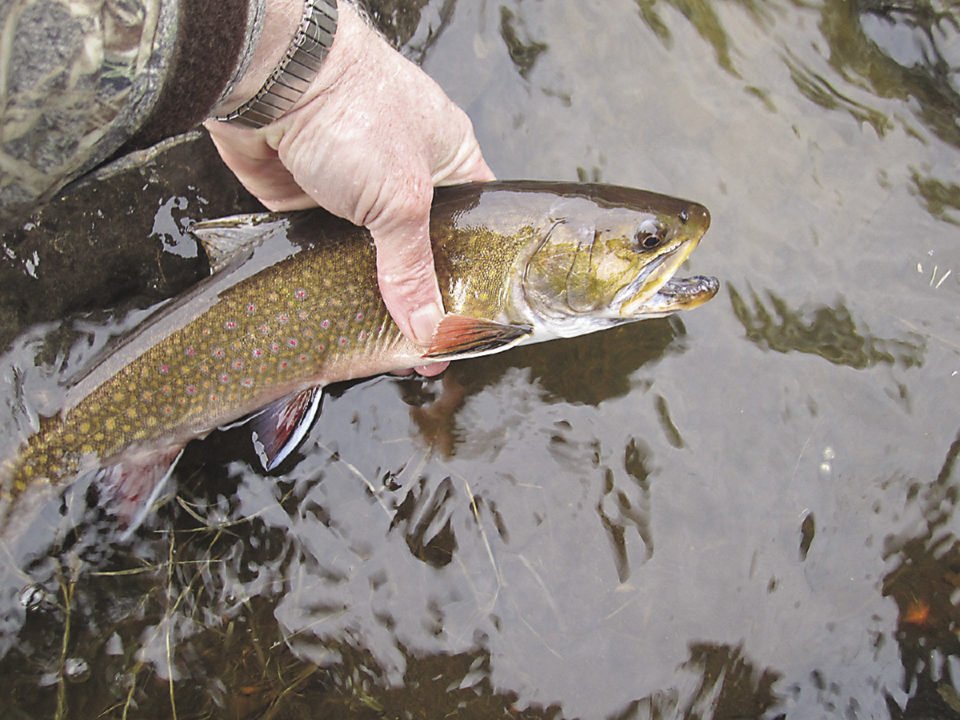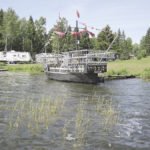For eight months, I’ve been waiting for now to arrive. Minnesota’s brook trout season in streams closed last Sept. 30. The season opened again in mid-April, when the north country was still cloaked in snow and ice. Then I was distracted by the spring steelhead run. Now is the time to grab the fly rod and insect repellent and head into the woods.
Brook trout have always been a part of my life. My father took my mother brook trout fishing on the Upper Sucker River a couple of weeks before I was born. Perhaps it was in the womb where I first heard the sounds of clear water tumbling over rocks and the song of the white-throated sparrow. All I know is that it has always been music to me.
Last year, I decided to spend more time fly-fishing for brook trout in headwaters of Lake Superior tributaries, seeking out those special, secret places where brook trout topping 12 inches in length exist. My measurement was arbitrary, but most seasoned brook trout anglers agree that brookies that size are trophies in North Shore streams.
I had a mental list of places to explore. What I needed was streams wide enough to make a backcast without tangling in the brush and deep enough to support larger trout. My criteria ruled out hundreds of miles of alder-shrouded creeks. But more water than I can explore in a lifetime remained.
I quickly discovered that brook trout fishing today is a mostly lost art. Apparently, few anglers have the gumption to brave the bugs and brush to hoof it into the remote, wild places where brook trout dwell. This wasn’t always so. Back in my father’s day, most everyone went brook trout fishing. Blazed trails led into distant beaver ponds and pathways followed along the creeks. Most anglers used a fly rod and they mostly fished with worms. The average brook trout were less than 12 inches in length, but generous limits allowed you to bring home a mess of them. Places where big brookies dwelled were closely guarded secrets.
Interest in brook trout creeks began to fade as the state expanded stockings of stream trout in small lakes, where the fish grew larger and were more easily accessible. As the angling community was smitten with walleye fever in the 70s and 80s, the blaze marks faded away and the pathways became overgrown. Such was the forest I walked into last summer.
I quickly discovered the brookies were still there, even if the anglers were not. Poking around at a place I’d never fished before, I stumbled into some sizeable brook trout. As for numbers, that place was quality over quantity. On other creeks, brookies were numerous, but small. Overall, it didn’t really matter. I enjoyed a summer of wonderful fishing.
I also came away with a long list of new places to explore. Since hardly anyone fishes the creeks anymore, folks are willing to share what were once closely-guarded secrets. “Have you ever been to…?” folks would ask me, then proceed to tell me about a deadwater or deep pool where big ones once dwelled. Occasionally we’d pull out a map to see exactly where the hotspot was located. I added them to my overstuffed mental file of promising fishing holes. Like many anglers, if I am introduced to you, I may forget your name before our conversation is over. But if you tell me a good place to go fishing, I’ll remember it forever.
Some brook trout waters are bridged by roads, while others are accessible with a canoe. Those are the easy ones. Most are a medium to long walk into the woods, often along marginal or nonexistent pathways. For me, this is part of the fun, even though it may not seem so when you are drenched in sweat, your fly rod is hopelessly tangled in the alders and squadrons of mosquitoes are on the attack. Is it any wonder most anglers choose the comparatively plush comfort of a pike boat?
The forest provides its own comfort. You can measure it in solitude, in the quiet that is not silence and in intoxicating breaths of sweet, fresh forest air. It may be in the moose that steps out on the far bank, the chatter of unseen ovenbirds or the swirl of a good trout taking your fly. When you fish for brook trout, you become fully immersed in their world.
The reward of this immersion is to hold the wondrous beauty that is a brook trout in your hand. They are a palette of living color that no artist or photographer can ever replicate. With olive backs, flaming bellies, white-edged fins and distinctive orange spots with blue halos along their flanks, no two brook trout are the same. I marvel at every one of them. Usually, but not always, I let them go. As anyone who has eaten brook trout knows, their beauty is more than skin deep.
All of this is why so many trout anglers have special regard for brookies, even if they don’t often fish for them. For many of us who learned how to fish for trout along the North Shore, brook trout were the entry point, even if we eventually moved on to more glamorous steelhead. No one but a fool speaks disparagingly of brook trout, and then usually be remarking they are “easy to catch.” Sure, I’ve been out there on days when that statement was true. But I’ve been skunked on many other days.
Ultimately, brook trout fishing may be less about catching them than it is about privilege of fishing for them. The one word that best describes brook trout habitat is pristine. They are wild jewels. Never am I so rich as when I am in their company.




